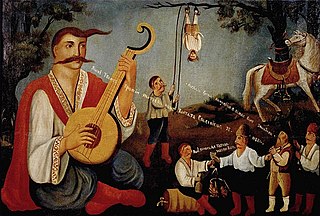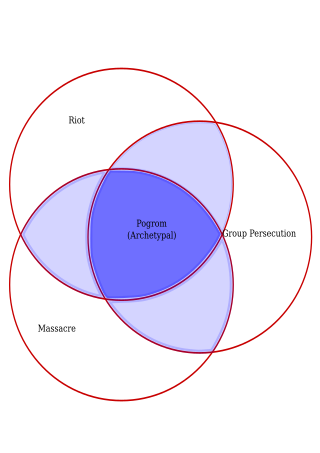
The Jewish Defense League (JDL) is a Jewish far-right religious-political organization in the United States and Canada, whose stated goal is to "protect Jews from antisemitism by whatever means necessary". It has been classified as "a right wing terrorist group" by the FBI since 2001, and is designated a hate group by the Southern Poverty Law Center. According to the FBI, the JDL has been involved in plotting and executing acts of terrorism within the United States. Most terrorism watch groups classify the group as inactive.

Kristallnacht (German pronunciation: [kʁɪsˈtalnaχt](listen)) or the Night of Broken Glass, also called the November pogrom(s) (German: Novemberpogrome, pronounced [noˈvɛm.bɐ.poˌɡʁoːmə](listen)), was a pogrom against Jews carried out by the Nazi Party's Sturmabteilung (SA) paramilitary and Schutzstaffel (SS) paramilitary forces along with some participation from the Hitler Youth and German civilians throughout Nazi Germany on 9–10 November 1938. The German authorities looked on without intervening. The name Kristallnacht (literally 'Crystal Night') comes from the shards of broken glass that littered the streets after the windows of Jewish-owned stores, buildings and synagogues were smashed. The pretext for the attacks was the assassination of the German diplomat Ernst vom Rath by Herschel Grynszpan, a 17-year-old German-born Polish Jew living in Paris.

A pogrom is a violent riot incited with the aim of massacring or expelling an ethnic or religious group, particularly Jews. The term entered the English language from Russian to describe 19th- and 20th-century attacks on Jews in the Russian Empire. Similar attacks against Jews which also occurred at other times and places retrospectively became known as pogroms. Sometimes the word is used to describe publicly sanctioned purgative attacks against non-Jewish groups. The characteristics of a pogrom vary widely, depending on the specific incident, at times leading to, or culminating in, massacres.

The Kielce pogrom was an outbreak of violence toward the Jewish community centre's gathering of refugees in the city of Kielce, Poland on 4 July 1946 by Polish soldiers, police officers, and civilians during which 42 Jews were killed and more than 40 were wounded. Polish courts later sentenced nine of the attackers to death in connection with the crimes.

The history of the Jews in Ukraine dates back over a thousand years; Jewish communities have existed in the modern territory of Ukraine from the time of the Kievan Rus'. Important Jewish religious and cultural movements, from Hasidism to Zionism, arose there. According to the World Jewish Congress, the Jewish community in Ukraine constitutes Europe's third-largest and the world's fifth-largest.

Antisemitism in Ukraine has been a historical issue in the country, particularly in the twentieth century. The history of the Jewish community of the region dates back to the era when ancient Greek colonies existed in it. A third of the Jews of Europe previously lived in Ukraine between 1791 and 1917, within the Pale of Settlement. The large concentration of Jews in this region historically made them an easy target for anti-Jewish actions and pogroms. Antisemitism in recent years has seen an increase in the country.
Anti-Jewish violence in Poland from 1944 to 1946 preceded and followed the end of World War II in Europe and influenced the postwar history of the Jews as well as Polish-Jewish relations. It occurred amid a period of violence and anarchy across the country, caused by lawlessness and anti-communist resistance against the Soviet-backed communist takeover of Poland. The estimated number of Jewish victims varies and ranges up to 2,000. In 2021, Julian Kwiek published the first scientific register of incidents and victims of anti-Jewish violence in Poland in 1944-1947, according to his calculations, the number of victims was at least 1,074 to 1,121. Jews constituted between 2% and 3% of the total number of victims of postwar violence in the country, including the Polish Jews who managed to escape the Holocaust on territories of Poland annexed by the Soviet Union, and returned after the border changes imposed by the Allies at the Yalta Conference. The incidents ranged from individual attacks to pogroms.

The Lwów pogrom was a pogrom perpetrated by Polish soldiers and civilians against the Jewish population of the city of Lwów. It happened on 21–23 November 1918, during the Polish–Ukrainian War that followed World War I.
Antisemitism —prejudice, hatred of, or discrimination against Jews— has experienced a long history of expression since the days of ancient civilizations, with most of it having originated in the Christian and pre-Christian civilizations of Europe.
The Topoľčany pogrom was an antisemitic riot in Topoľčany, Slovakia, on 24 September 1945 and the best-known incident of postwar violence against Jews in Slovakia. The underlying cause was resurgent antisemitism directed at Jewish Holocaust survivors who demanded the return of property that had been stolen during the Holocaust. Rumors spread that a local Catholic school would be nationalized and the nuns who taught there replaced by Jewish teachers.
The anti-Jewish violence in Central and Eastern Europe following the retreat of Nazi German occupational forces and the arrival of the Soviet Red Army – during the latter stages of World War II – was linked in part to postwar anarchy and economic chaos exacerbated by the Stalinist policies imposed across the territories of expanded Soviet republics and new satellite countries. The anti-semitic attacks had become frequent in Soviet towns ravaged by war; at the marketplaces, in depleted stores, in schools, and even at state enterprises. Protest letters were sent to Moscow from numerous Russian, Ukrainian and Belarusian towns by the Jewish Anti-Fascist Committee involved in documenting the Holocaust.
Antisemitic incidents escalated worldwide in frequency and intensity during the Gaza War, and were widely considered to be a wave of reprisal attacks in response to the conflict.
The Przytyk pogrom or Przytyk riots occurred between the Polish and Jewish communities in Przytyk, Radom County, Kielce Voivodeship, Second Polish Republic, on March 9, 1936. Previously, on January 28, authorities had suspended the weekly market for four weeks because of the fear of violence from the violent anti-Semitic Endek party. The disorder began as a small dispute between a Jewish baker and a Polish farmer selling his wares. Disturbances took on such a severe dimension as a result of the use of firearms by Jews. According to historian Emanuel Melzer, it was the most notorious incident of antisemitic violence in Poland in the interwar period, and attracted worldwide attention, being one of a series of pogroms that occurred in Poland during the years immediately before the outbreak of World War II. The term pogrom is contested by some sources, who are asserting that the word "riot" might be more suitable as the violence was unplanned and some Polish historians hold the opinion that the Jewish side might have started the disturbance.

The 1945 Anti-Jewish riots in Tripolitania was the most violent rioting against Jews in North Africa in modern times. From November 5 to November 7, 1945, more than 140 Jews were killed and many more injured in a pogrom in British-military-controlled Tripolitania. 38 Jews were killed in Tripoli from where the riots spread. 40 were killed in Amrus, 34 in Zanzur, 7 in Tajura, 13 in Zawia and 3 in Qusabat.

This article provides a list of definitions of the term pogrom. The term originated as a loanword from the Russian verb громи́ть, meaning "to destroy, to wreak havoc, to demolish violently". The events in Odessa during Holy Week in 1871 were the first to be widely called a "pogrom" in Russian, and the events of 1881–82 introduced the term into common usage throughout the world.
Belgium is a European country with a Jewish population of approximately 35,000 out of a total population of about 11.4 million. It is among the countries experiencing an increase in both antisemitic attitudes and in physical attacks on Jews.

The 1934 Constantine riots was an anti-Jewish riot that erupted in the Algerian city of Constantine. The background of the tension between Jews and Muslims in the city was rooted in the different manner in which Jews and Muslims had been treated in the Algerian state by the French colonial government. It is uncertain what the exact cause of the riots was, though various accounts suggest that the riots were triggered by an altercation between a Jewish man and some Muslims at the Sidi Lakhdar Mosque in Constantine. Multiple sources report that 25 Jews and 3 Muslims died over the course of the three-day riot, and several Jewish establishments were pillaged. The events have also been described as a pogrom.

This timeline of antisemitism chronicles the facts of antisemitism, hostile actions or discrimination against Jews as a religious or ethnic group, in the 20th century. It includes events in the history of antisemitic thought, actions taken to combat or relieve the effects of antisemitism, and events that affected the prevalence of antisemitism in later years. The history of antisemitism can be traced from ancient times to the present day.
Postwar anti-Jewish violence in Slovakia resulted in at least 36 deaths of Jews and more than 100 injuries between 1945 and 1948, according to research by the Polish historian Anna Cichopek. Overall, it was significantly less severe than in Poland. The causes of the violence included antisemitism and conflict over the restitution of property stolen from Jews during the Holocaust in Slovakia.
In June 1967, an anti-Jewish pogrom took place in the Libyan city of Tripoli.











